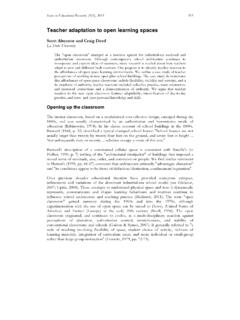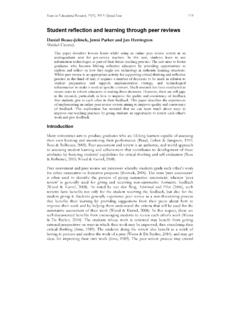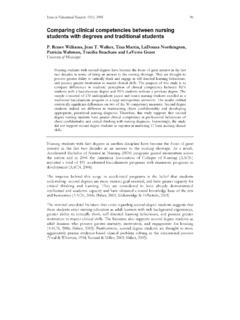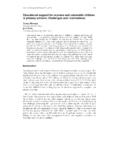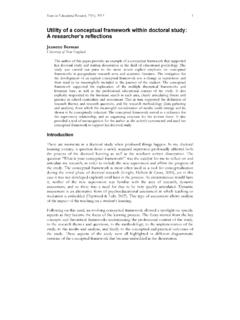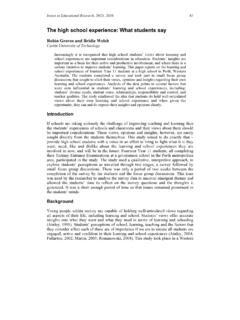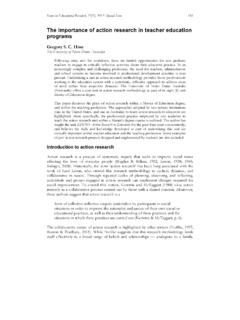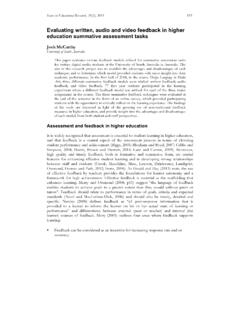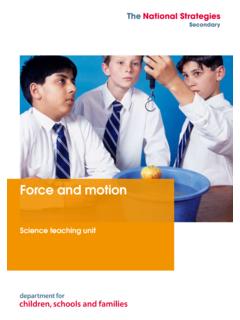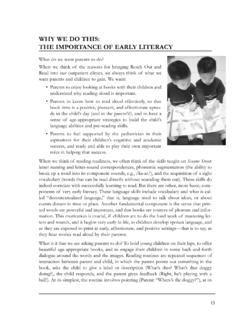Transcription of Catherine Moore and Susan Teather Edith Cowan …
1 196 Issues in Educational Research, 23(2), 2013: Special Issue Engaging students in peer review: Feedback as learning Catherine Moore and Susan Teather Edith Cowan university There is a growing interest in tertiary education in Australia about developing the capacity of learners to evaluate and improve both their own work and that of others (Boud & Falchikov, 2006; Oliver, 2011). In order to successfully direct their own learning beyond university (and engage in lifelong learning ), students need to be able to evaluate their performance in relation to a standard, identify gaps, and determine how to bridge them in order to achieve the desired standard if required.
2 One strategy that can be employed to help students achieve this is engaging them actively in a feedback process, so that feedback becomes an integral part of learning . In this paper the authors define feedback as a loop, meaning that the feedback process is only complete when there is not only some identifiable influence on the recipient of the feedback (Boud & Molloy, 2012), but feedback results in improved performance a sign that learning has occurred. This paper describes how peer feedback was embedded in a third year social studies unit.
3 Pre and post surveys of students reveal their responses to the requirement that they actively engage in evaluation and feedback. This paper explores how engaging students in peer review as part of a major assessment task affected their learning , their capacity to direct their learning , and their self-efficacy in relation to academic and real-world tasks. Introduction Feedback is an important, high-profile issue in higher education. In Australia the course experience questionnaires indicate that graduates are more dissatisfied with feedback than any other feature of their course (James, Krause & Jennings, 2010).
4 Feedback that does not result in change is merely, as Sadler (1989, p. 121) so aptly describes it, dangling data . The challenge then is for higher education to reposition feedback as a practice that has a positive and sustained influence on learning (Boud & Molloy, 2012, p. 2). To this end, David Nicol (2010) called for a dialogic approach to feedback, and Boud (2012) called for an approach wherein feedback is central to the curriculum and includes calibration of student judgment.
5 Feedback can motivate and improve learning , so it is essential for students to be provided with effective, timely and appropriate feedback (Pearce, Mulder & Baik, 2009). Feedback that focuses on growth rather than grading (Sadler, 1983, p. 60) tends to make sense to students and is far more likely to advance student learning than feedback that does not make sense to students (Gibbs & Simpson, 2004). Students are more motivated to engage with and use feedback when the immediate utility of that feedback is clear.
6 They want feedback to be something that helps them do better in the next task or, when feedback is given on drafts, something that can immediately be used to improve the final product (Price, Handley, Millar & O Donovan, 2010). The difficulty students have in interpreting feedback was also highlighted by Price et al. (2010) who reported that written feedback without dialogue is often viewed by students as Moore & Teather 197 frustrating and can lead to disengagement.
7 They further noted student perceptions that dialogue and discussing examples of work assists interpretation of feedback and increases the utility of feedback. Black and Wiliam (1998) referred to the substantial evidence from research that demonstrates classroom assessment will most effectively enhance learning when learners: clearly understand the criteria by which their work will be judged; are able to identify both their current level of achievement and the desired level of achievement; are able to obtain information about the gap and about how to close the gap; and actually use this information to close the gap.
8 Engagement in the process of formative assessment improves academic outcomes (Rust, O Donovan & Price, 2006), and active engagement in peer assessment produces better structured interaction between students, as well as more organised written work (van den Berg, Admiraal & Pilot, 2006). In particular, giving feedback has been shown to have considerable benefits for student learning (Li, Liu & Steckelberg, 2009). Nicol and MacFarlane-Dick (2006) noted that providing feedback by commenting on the work of peers enables students to develop an understanding of standards which they potentially can then transfer to their own work.
9 This paper outlines a feedback process involving several related activities which facilitated student understanding of the criteria by which their work would be judged, developed their capacity to identify both current and desired levels of achievement, generated information about how to close any gap, and gave them the opportunity to use that information to actually close the gap. We believe this to be a sustainable feedback process (Hounsell, 2007) as it contains the four characteristics of sustainable feedback as identified by Carless, Salter, Yang and Lam (2011): 1.
10 Student dialogue about what constitutes quality; 2. processes requiring students to monitor and evaluate learning ; 3. processes supporting student planning of learning ; and 4. student engagement over time in feedback used to enhance performance on multiple stages of assignments. This paper also describes how a sustainable feedback process was integrated into this unit. Integration began when students were engaged in dialogue about what constitutes quality very early in the semester as they worked collaboratively to review sample assignments.
